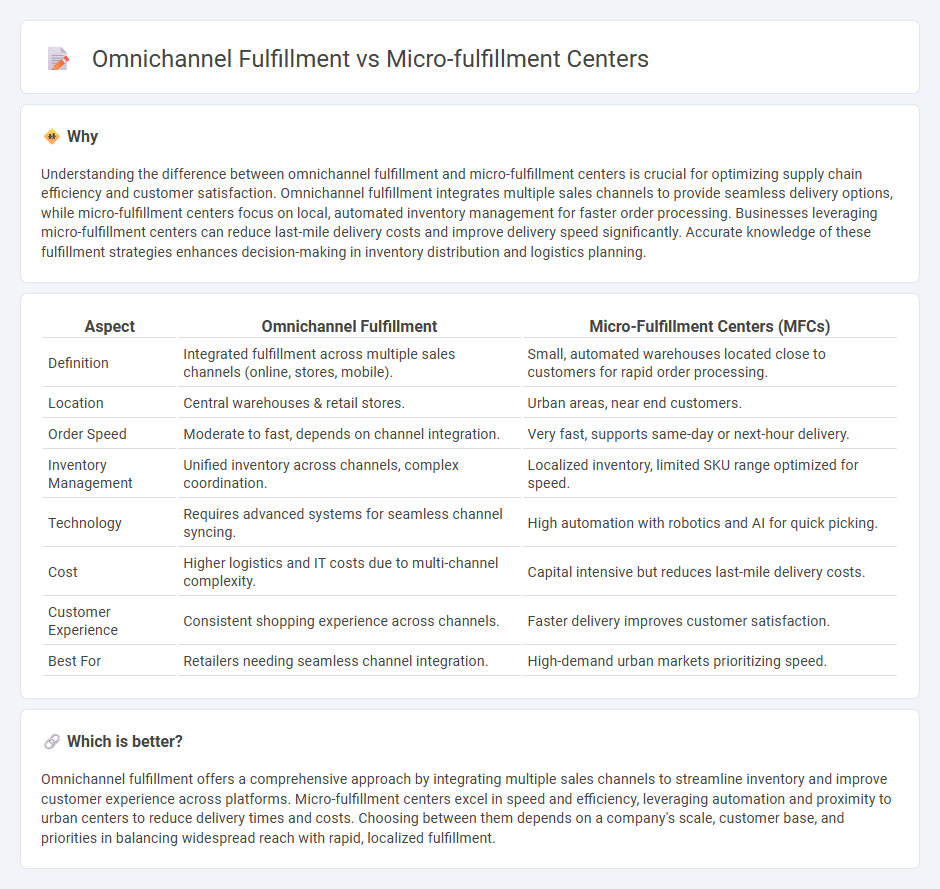
Omnichannel fulfillment integrates multiple sales channels to streamline order processing and delivery, enhancing customer experience through flexible options like in-store pickup or home delivery. Micro-fulfillment centers are compact warehouses located near urban areas, leveraging automation to speed up order fulfillment and reduce last-mile delivery costs. Explore how these innovative strategies transform supply chain efficiency and customer satisfaction.
Why it is important
Understanding the difference between omnichannel fulfillment and micro-fulfillment centers is crucial for optimizing supply chain efficiency and customer satisfaction. Omnichannel fulfillment integrates multiple sales channels to provide seamless delivery options, while micro-fulfillment centers focus on local, automated inventory management for faster order processing. Businesses leveraging micro-fulfillment centers can reduce last-mile delivery costs and improve delivery speed significantly. Accurate knowledge of these fulfillment strategies enhances decision-making in inventory distribution and logistics planning.
Comparison Table
| Aspect | Omnichannel Fulfillment | Micro-Fulfillment Centers (MFCs) |
|---|---|---|
| Definition | Integrated fulfillment across multiple sales channels (online, stores, mobile). | Small, automated warehouses located close to customers for rapid order processing. |
| Location | Central warehouses & retail stores. | Urban areas, near end customers. |
| Order Speed | Moderate to fast, depends on channel integration. | Very fast, supports same-day or next-hour delivery. |
| Inventory Management | Unified inventory across channels, complex coordination. | Localized inventory, limited SKU range optimized for speed. |
| Technology | Requires advanced systems for seamless channel syncing. | High automation with robotics and AI for quick picking. |
| Cost | Higher logistics and IT costs due to multi-channel complexity. | Capital intensive but reduces last-mile delivery costs. |
| Customer Experience | Consistent shopping experience across channels. | Faster delivery improves customer satisfaction. |
| Best For | Retailers needing seamless channel integration. | High-demand urban markets prioritizing speed. |
Which is better?
Omnichannel fulfillment offers a comprehensive approach by integrating multiple sales channels to streamline inventory and improve customer experience across platforms. Micro-fulfillment centers excel in speed and efficiency, leveraging automation and proximity to urban centers to reduce delivery times and costs. Choosing between them depends on a company's scale, customer base, and priorities in balancing widespread reach with rapid, localized fulfillment.
Connection
Omnichannel fulfillment relies on micro-fulfillment centers to enhance inventory management and speed up order processing across multiple sales channels. Micro-fulfillment centers strategically located near urban hubs reduce delivery times and lower last-mile shipping costs, improving customer satisfaction. This synergy enables retailers to efficiently fulfill online and in-store orders, optimizing supply chain agility and inventory turnover.
Key Terms
Last-Mile Delivery
Micro-fulfillment centers enhance last-mile delivery by enabling faster order processing through strategically located urban warehouses, reducing delivery times and costs. Omnichannel fulfillment integrates multiple sales channels to optimize inventory distribution and provide flexible delivery options, improving customer satisfaction across touchpoints. Explore how combining micro-fulfillment with omnichannel strategies can revolutionize your last-mile delivery efficiency.
Inventory Management
Micro-fulfillment centers leverage localized, automated storage systems to optimize inventory turnover and reduce last-mile delivery times, enhancing real-time stock visibility and accuracy. Omnichannel fulfillment integrates inventory across multiple sales channels, enabling seamless stock allocation and preventing overstock or stockouts through centralized demand sensing and replenishment strategies. Discover how these approaches revolutionize inventory management to boost supply chain efficiency and customer satisfaction.
Order Consolidation
Micro-fulfillment centers enhance order consolidation by centralizing inventory in compact urban locations, enabling faster picking and packing of multiple SKUs within a single order. Omnichannel fulfillment integrates various sales channels and distribution points, optimizing consolidation by coordinating online and offline inventory to reduce shipping costs and delivery times. Explore more to understand how these strategies improve supply chain efficiency and customer satisfaction.
Source and External Links
Micro-Fulfillment Explained: Key Benefits and Strategies for Ecommerce Success - Micro-fulfillment centers are small, highly compact warehouses located near consumers, typically 3,000 to 10,000 square feet, stocking up to 15,000 fast-moving items to enable rapid delivery and improve supply chain efficiency by reducing last-mile delivery times and costs, with the grocery sector being a major adopter.
Micro-Fulfilment: In-Depth Guide + 7 Real Examples - Companies like Gopuff and Shoprite use micro-fulfillment centers as part of hyper-local, B2B fulfillment strategies to provide same-day delivery, streamline order capacity, and respond flexibly to consumer demand, enhancing customer convenience with options like curbside pickup and home delivery.
What Are Micro Fulfillment Centers? - MFCs differ from traditional large warehouses by focusing on fast-moving products with faster inventory turnover rates (8-10 times per year versus once or twice in conventional warehouses) and leveraging automation or human pickers to fulfill individual online orders, with predictions of widespread adoption in grocery retail by 2030.
 dowidth.com
dowidth.com